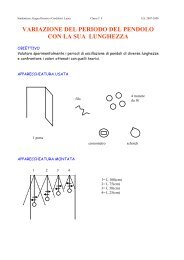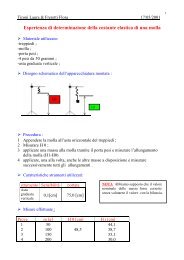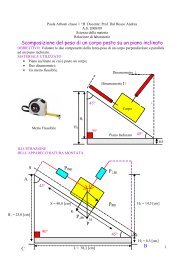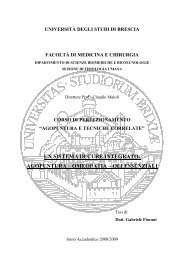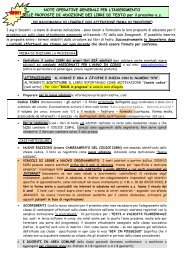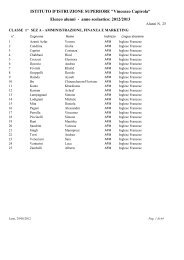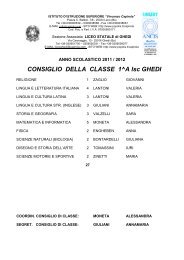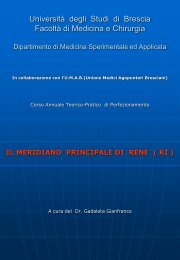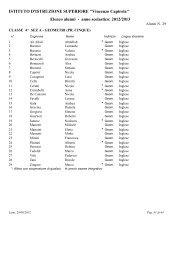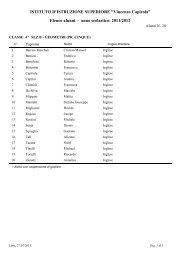Leggi di Lavoisier e di Proust - in inglese - Popolis
Leggi di Lavoisier e di Proust - in inglese - Popolis
Leggi di Lavoisier e di Proust - in inglese - Popolis
You also want an ePaper? Increase the reach of your titles
YUMPU automatically turns print PDFs into web optimized ePapers that Google loves.
4) Brief theoretical premiseThe <strong>Lavoisier</strong>’s law affirms that, dur<strong>in</strong>g a chemical reaction, the mass does not change.m reagent= m products: “noth<strong>in</strong>g is created, noth<strong>in</strong>g is destroied, but only transformed.”The <strong>Proust</strong>’s law states that, when two elements react to form a compound they do it accor<strong>di</strong>ng toa def<strong>in</strong>ed ratio of masses.5) Description of the stages do<strong>in</strong>g the experience1. Phase: to reset the balance (optional);2. Phase: to put the empty small glass conta<strong>in</strong>er on the <strong>di</strong>gital electronic balance A) and to reset it;3. Phase: to value the mass of the iron (1g) on the balance sett<strong>in</strong>g it <strong>in</strong>to the small glass conta<strong>in</strong>erB)4. Phase to repeat the phase 2 with the other small glass conta<strong>in</strong>er A).5. Phase to value the mass of the sulphur (0,57g) C) putt<strong>in</strong>g it <strong>in</strong>to the other small glass conta<strong>in</strong>erplaced on the balance;6. Phase: to weigh the empty test tube D);7. Phase: to put the iron and the sulphur <strong>in</strong>to the test tube us<strong>in</strong>g the funnel and with a th<strong>in</strong> glassstick to mix the mixture <strong>in</strong> order to make it more homogeneous, E);8. Phase: to heat the test tube conta<strong>in</strong><strong>in</strong>g the mixture on the gas stove for about five m<strong>in</strong>utes F);9. Phase: to wait until the chemical reaction occours; later, when the test tube is cooled, take itaway from the gas stove and set it on the balance;10. Phase: to value with the balance the mass of the test-tube conta<strong>in</strong><strong>in</strong>g the ferrous sulphide (FeS)G;)11. Phase: to check if the <strong>Lavoisier</strong>’ law and the <strong>Proust</strong>’s law and have been proved;12. Phase: to prove that the test tube with the FeS is attracted by the magnet H) and to break thetest tube with a weight <strong>in</strong> order to observe the product of the reaction;13. Phase: to gather the data <strong>in</strong> a table;14. Phase: to calculate the percentage error compar<strong>in</strong>g the mass of the reagent with that on of theproduct.6) Physical quantities measuredQuantity Symbol Units Instrumentmass m (g) Digital electronic Balance7) Characteristics of the <strong>in</strong>struments used for the data logg<strong>in</strong>gInstrumentResolution CapacityDigital electronic Balance 0,01(g) 1000(g)8) Gathered dataMFe=y1(g) MS=y2(g) M empty test M test tube E%(M)tube=y3 (g) +FeS(g)= y41,00 0,57 15,92 17,49 0



